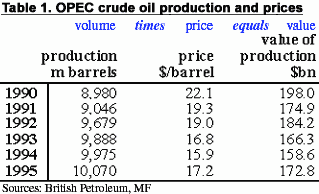Volume, value and price
When interpreting economic figures it is important to distinguish between the effects of inflation and changes in the real level of economic activity. Indicators measure one of three things:
| Volume, such as tons of steel or barrels of oil; | |
| Value, such as the market value of steel or oil produced in one month or year; or | |
| Price, such as the market price of 1 ton of steel or 1 barrel of oil. |
The relationship between these three is simple. Volume times price equals value.
There is one possible complication. If the volume of oil or steel produced each year is valued in the prices ruling in, say, 1995, the result is an indicator of output in "1995 price terms". Such a series is in money units, but it is a volume indicator because it provides information about changes in volumes not prices. This is known also as output in constant prices, real prices or real terms.
The value of steel output measured in actual selling prices is known as a current price or nominal price series or a series in nominal terms. Thus:
| Values, current prices, nominal prices and nominal terms include the effects of inflation; while | |
| Volumes, constant prices, real prices and real terms exclude any inflationary influences. |

In Table 2 column A shows the money value of annual American economic output (gross domestic product or GDP), which reflects changes in both output and prices. The next two columns disentangle these factors. Column B shows the volume of output with all goods and services measured in 1987 prices. Column C indicates the path of inflation (but see the comment on current-weighted index numbers below).
The value of output rose in 1990-91 (from $5,744bn to $5,917bn), yet in terms of the prices ruling in 1992, real output fell over the same period (from $6,139bn to $6,079bn).
Price indicators used to convert between current and constant prices (to deflate) are sometimes called price deflators.
| Current price series divided by constant price series (/ 100) equals the price deflator. | |
| Current price series divided by price deflator (/ 100) equals the constant price series. | |
| Constant price series times the price deflator (* 100) equals current price series. |
Any series of numbers can be converted into index numbers, as described below for the constant price series in Table 2 column E.
Step 1 A reference base is selected, 1992 in this case.
Step 2 The value in the reference base is divided by 100 (6,244 / 100 = 62.44).
Step 3 All numbers in the original series are divided by the result of step 2. For example, the index value for 1990 is 6,138 / 62.44 = 98.3.

Related topics:
| Index numbers |